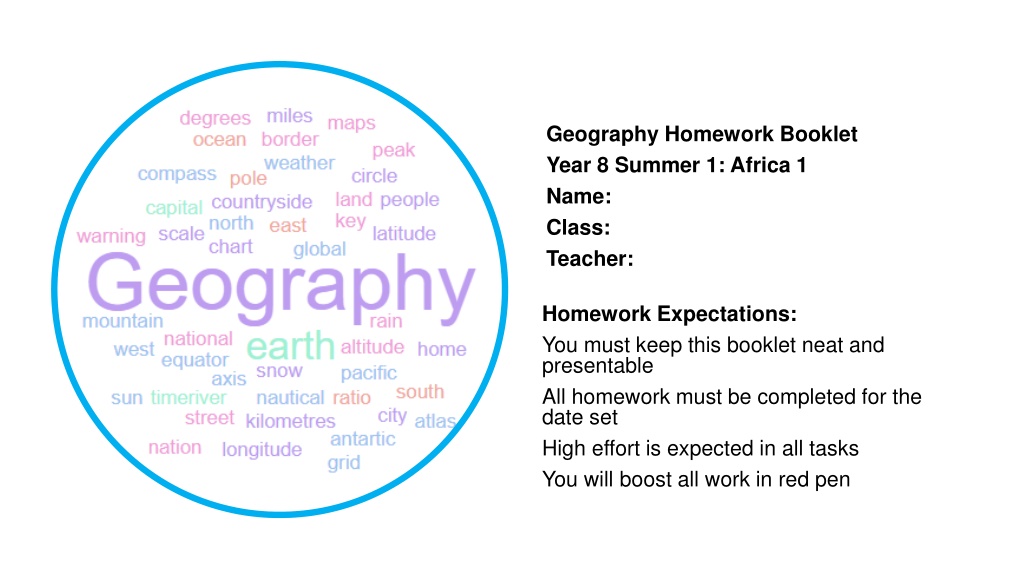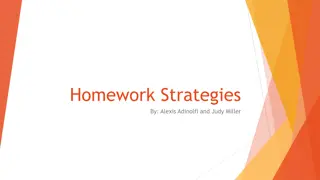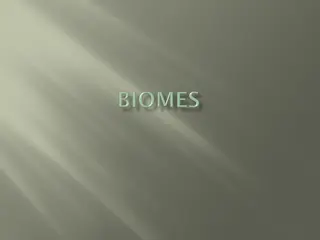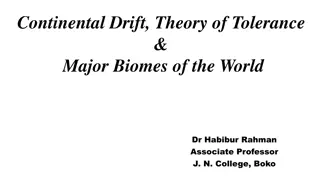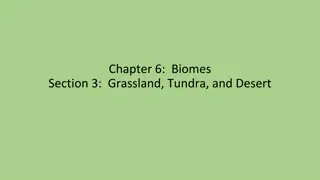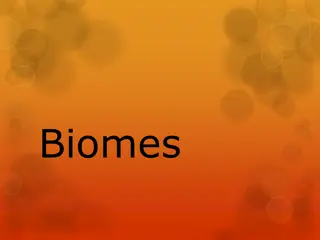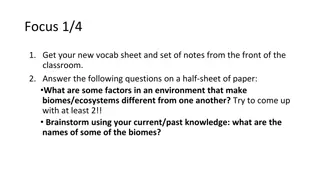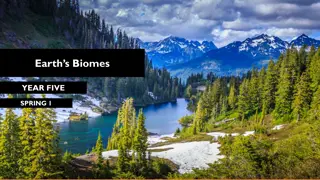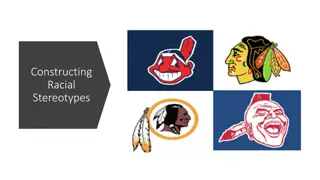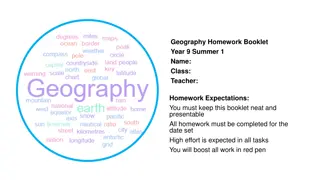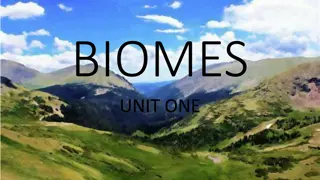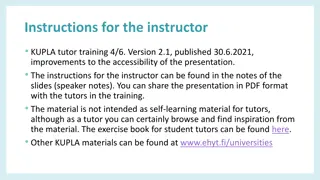Exploring African Biomes and Stereotypes in Year 8 Geography Homework
In this Year 8 Geography Homework booklet, students delve into the diverse biomes of Africa, challenge stereotypes, and work on climate studies. Tasks include defining stereotypes, mapping misconceptions, studying African biomes, and analyzing the climate of Algeria. The assignments aim to broaden students' awareness of Africa's rich environments while promoting critical thinking and overcoming preconceived notions.
Download Presentation

Please find below an Image/Link to download the presentation.
The content on the website is provided AS IS for your information and personal use only. It may not be sold, licensed, or shared on other websites without obtaining consent from the author. Download presentation by click this link. If you encounter any issues during the download, it is possible that the publisher has removed the file from their server.
E N D
Presentation Transcript
Geography Homework Booklet Year 8 Summer 1: Africa 1 Name: Class: Teacher: Homework Expectations: You must keep this booklet neat and presentable All homework must be completed for the date set High effort is expected in all tasks You will boost all work in red pen
Year 8 Weekly Homework Summer 1.1 A Single-Story Africa 1a. Define the word Stereotype 3a. Why is it important that we overcome these stereotypes and misconceptions? ____________________________________________________________________________ ____________________________________________________________________________ ____________________________________________________________________________ ____________________________________________________________________________ ____________________________________________________________________________ 1b. Where do our stereotypes come from? Bullet point your answers: ____________________________________________________________________________ ____________________________________________________________________________ 3b. Suggest 3 ways we can overcome these stereotypes and misconceptions: 2. Mind-map as many stereotypes and misconceptions you know exist about Africa: 4. Connect these words (you must make at least 4 connections): Media Prejudice All of Africa is poor Stereotypes Stereotypes about Africa Africa Unfair/ Untrue Diverse
Year 8 Weekly Homework Summer 1.2 TheBiomes of Africa Knowledge Book Page 41-42 1a. Define the following key terms: 2. Study the map on P42 Describe the distribution of Africa s biomes: _________________________________________________ _________________________________________________ _________________________________________________ _________________________________________________ _________________________________________________ _________________________________________________ _________________________________________________ _________________________________________________ _________________________________________________ _________________________________________________ _________________________________________________ Biome- _____________________________________________________________________ Climate- ____________________________________________________________________ ____________________________________________________________________________ 1b. List 3 biotic (living) components in an ecosystem: 1c. List 3 abiotic (non-living) components in an ecosystem: 3. Decide if the following statements are TRUE or FALSE: 4. Label these countries on the diagram: Algeria a) Africa has many different climates and biomes ____________ Somalia b) The main biomes of Africa are Mountainous and Tundra ____________ Zambia c) Tropical Rainforest biome is found in central Africa ____________ Cameroon d) Northern Africa is mainly Desert and Savannah biome ____________ e) Savannah Grasslands experience all 4 seasons ____________ f) Deciduous woodlands are considered an extreme environment ____________
Year 8 Weekly Homework Summer 1.3 Africa s Climate Knowledge Book P42 1. Study the Algeria Desert Biome graph on P42 - Draw the temperature line onto the graph below: 3. Fill in the key terms and definitions for the following: Key Term Definition Stakeholder Money and Jobs. Social Environmental The Government 2. Use P42. Answer these questions about the 4 African climates: 4. Explain two characteristic of the Tropical Rainforest biome: One characteristic of this biome is _________________________________________ a) Name the wettest biome. ____________________________________________ _____________________________________________________________________ b) Which biome has the largest range in temperature? _______________________ This means that ______________________________________________________ _____________________________________________________________________ c) Which biome only experiences 2 seasons? ______________________________ _____________________________________________________________________ d) TRUE or FALSE: There are no seasons in the Tropical Rainforest. ____________ Another characteristic of this biome is ______________________________________ e) Which is the wettest month in Zambia? _________________________________ _____________________________________________________________________ This means that ______________________________________________________ f) Which biome experiences the hottest temperatures? _______________________ _____________________________________________________________________ _____________________________________________________________________
Year 8 Weekly Homework Summer 1.4 Africa s Physical Landscape Knowledge Book 43 1a. What is a physical feature? 3. Study the table on P43. Select one of the 6 physical features and create a fact file poster on your chosen feature (include: pictures/ drawings/ facts & info/ location/ countries): ____________________________________________________________________________ ____________________________________________________________________________ 1b. Draw an icon/ image to help you remember what a physical features is: 2. Study the table on P43. Answer the following questions: a) How many miles do the Atlas Mountains extend for? ______________________________ b) What type of landform is Mt Kilimanjaro? _______________________________________ c) In which direction does the Rive Nile flow? ______________________________________ d) Which type of plate boundary formed the Great Rift Valley? ________________________ e) 25% of the African continent is covered by which landform? ________________________ f) In which African country is Mt Kilimanjaro located? _______________________________ g) This landform forms a border between Zambia and Zimbabwe?______________________ h) Who were the original inhabitants of the Atlas Mountains? _________________________ i) How large is the Sahara Desert? ______________________________________________ j) This landform was made a World Heritage site in 1989? ___________________________
Year 8 Weekly Homework Summer 1.5 Waterfalls and Steep-Sided Gorges KB: P44 P45 1. Use P45 to label the diagram below using the key terms provided: 3. Use P44 to define the following key terms: Erosion- ____________________________________________________________________ Waterfall retreats Deposition- _________________________________________________________________ Overhang 4. What is the difference between saltation and traction ? Soft Rock ____________________________________________________________________________ Hard Rock Plunge Pool ____________________________________________________________________________ Waterfall ____________________________________________________________________________ Fallen Rocks ____________________________________________________________________________ 5. Match the term to the definition 2. Use P45 to describe the formation of a waterfall and steep-sided gorge [6 marks] ____________________________________________________________________________ Key Term Definition ____________________________________________________________________________ Hydraulic Action Rocks carried by the river rub and scrape along the riverbed and banks, wearing them down. ____________________________________________________________________________ ____________________________________________________________________________ Abrasion Slightly acidic water dissolves certain types of rock. ____________________________________________________________________________ Attrition The force of the river water compresses air into cracks along the river banks. ____________________________________________________________________________ ____________________________________________________________________________ Solution Rocks carried by the river collide with each other and break into smaller pieces. ____________________________________________________________________________ ____________________________________________________________________________
Questions to ask: ___________________________ ___________________________ ___________________________ ___________________________ ___________________________ ___________________________ ___________________________ ___________________________ ___________________________ ___________________________ ___________________________ ___________________________ ___________________________ ___________________________ ___________________________ ___________________________ ___________________________ Notes: ___________________________ ___________________________ ___________________________ ___________________________ ___________________________ ___________________________ ___________________________ ___________________________ ___________________________ ___________________________ ___________________________ ___________________________ ___________________________ ___________________________ ___________________________ ___________________________ ___________________________
Questions to ask: ___________________________ ___________________________ ___________________________ ___________________________ ___________________________ ___________________________ ___________________________ ___________________________ ___________________________ ___________________________ ___________________________ ___________________________ ___________________________ ___________________________ ___________________________ ___________________________ ___________________________ Notes: ___________________________ ___________________________ ___________________________ ___________________________ ___________________________ ___________________________ ___________________________ ___________________________ ___________________________ ___________________________ ___________________________ ___________________________ ___________________________ ___________________________ ___________________________ ___________________________ ___________________________
Questions to ask: ___________________________ ___________________________ ___________________________ ___________________________ ___________________________ ___________________________ ___________________________ ___________________________ ___________________________ ___________________________ ___________________________ ___________________________ ___________________________ ___________________________ ___________________________ ___________________________ ___________________________ Notes: ___________________________ ___________________________ ___________________________ ___________________________ ___________________________ ___________________________ ___________________________ ___________________________ ___________________________ ___________________________ ___________________________ ___________________________ ___________________________ ___________________________ ___________________________ ___________________________ ___________________________
Questions to ask: ___________________________ ___________________________ ___________________________ ___________________________ ___________________________ ___________________________ ___________________________ ___________________________ ___________________________ ___________________________ ___________________________ ___________________________ ___________________________ ___________________________ ___________________________ ___________________________ ___________________________ Notes: ___________________________ ___________________________ ___________________________ ___________________________ ___________________________ ___________________________ ___________________________ ___________________________ ___________________________ ___________________________ ___________________________ ___________________________ ___________________________ ___________________________ ___________________________ ___________________________ ___________________________
